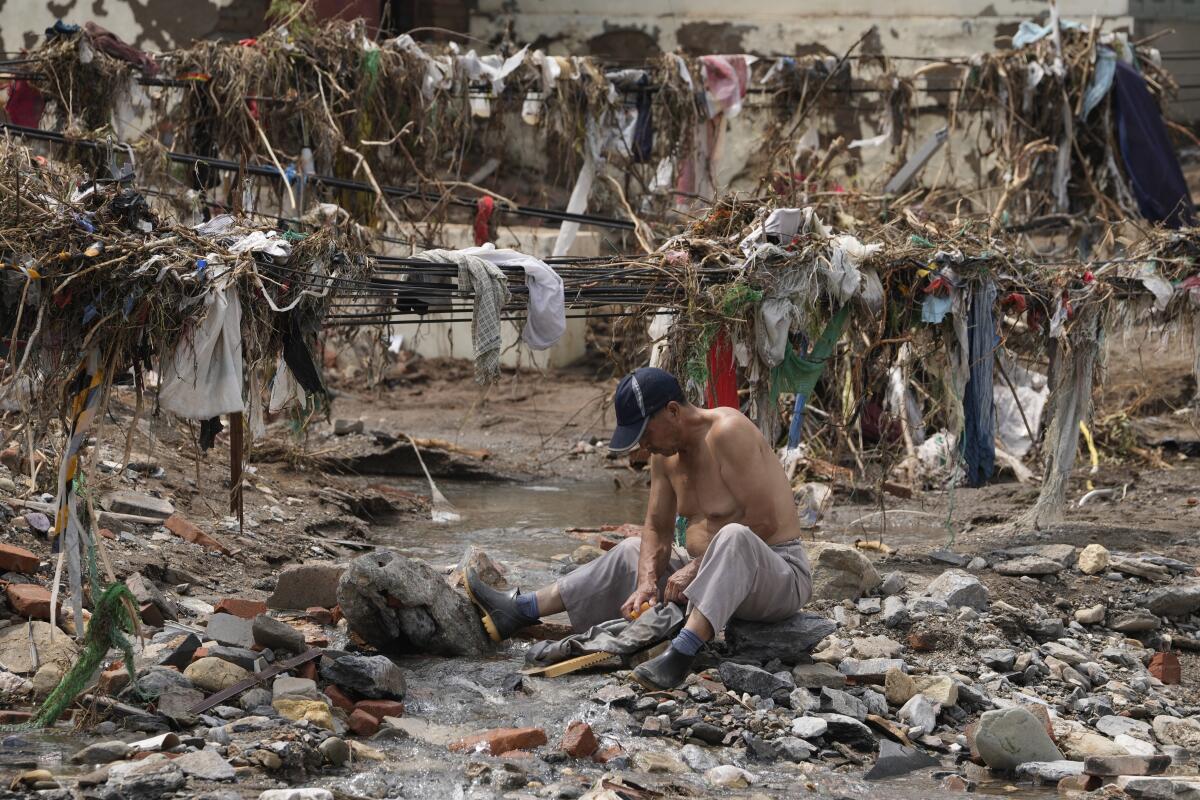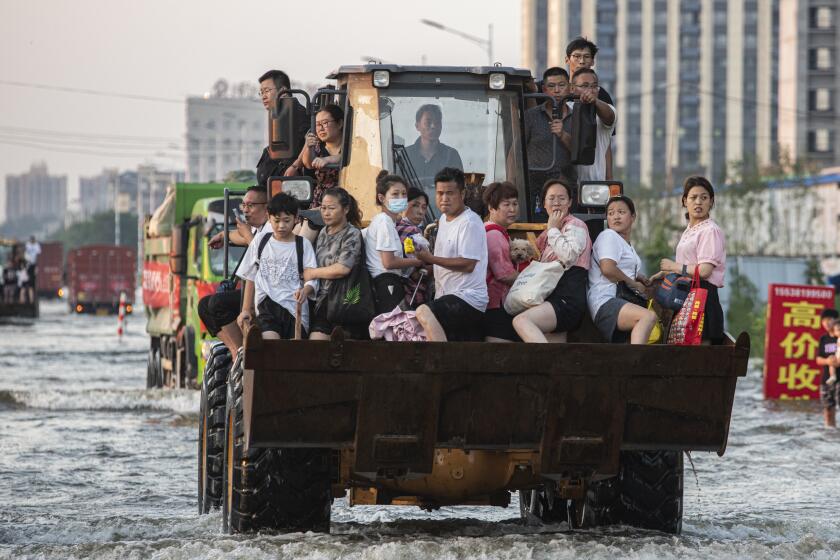Deadly flooding in China worsens as rescues and evacuations intensify

- Share via
BEIJING — Tens of thousands of people threatened by storm-swollen rivers were evacuated in China’s northeast Friday while areas on the outskirts of Beijing cleared debris from flooding that wrecked roads, knocked out power and left neighborhoods a shambles.
China is struggling with record-breaking rains in some areas while others suffer scorching summer heat and drought that threatens crops. Flooding near Beijing and in neighboring Hebei province this week killed at least 22 people.
Resident Xie Xin, on the western outskirts of Beijing, said the floodwaters had risen so fast that his family’s house was submerged in less than 10 minutes.
“Objects can be replaced,” said Xie, 25, as he moved a desk. “But neighbors that have gone missing, this is what hits me the most.”
In the northeast, some 54,000 people were forced out of their homes around Harbin, the biggest city in Heilongjiang province, the official Xinhua News Agency reported. It said rescue crews in 81 boats were evacuating residents.
On Thursday, a highway bridge in Heilongjiang collapsed, sending two cars plunging into the Mudan River, according to state media. There was no word on possible deaths or injuries.
The Haihe River basin, which includes Beijing and other major cities, was experiencing its heaviest flooding since 1963, the Ministry of Water Resources said Friday.
Chinese state media say days of heavy rains around China’s capital, Beijing, have flooded houses, torn apart roads and left at least 20 people dead and many missing.
The death toll in Hebei and Beijing rose to 22 after the body of a volunteer rescuer was found in a river. Another rescuer was declared dead Wednesday after a rubber boat flipped in a raging river.
Beijing usually has dry summers, but had a stretch of record-breaking heat this year that broke over the weekend with almost a week of constant rain and drizzle. Power was knocked out in areas, public transport and summer classes were suspended, and the more than 20 million residents of the greater Beijing area were told to stay home.
The nearby cities of Tianjin and Zhuozhou were also hit hard. Fire services aided by volunteer rescue groups searched apartment buildings and railway tunnels for stranded people, bringing hundreds to safety.
With its status as the nation’s capital, the headquarters of the ruling Communist Party and home to cultural treasures such as the ancient Forbidden City, Beijing has provided special protection from flooding through the diversion of waters to neighboring regions. That sparked complaints on social media Friday of flooding in surrounding areas that some say could have been avoided if the rainwater had been flushed through the capital’s system of canals and rivers.
“Do people in another city have to be superior and sacrifice this place to protect them?” said a posting on the Sina Weibo social media platform. “I think it’s really unspeakable.”
In Mentougou, a district of more than 260,000 people on the western outskirts of Beijing, residents on Friday were clearing mud out of their homes. The district was the hardest hit around the capital.
Streets turn into canals in China’s capital, which has recorded its heaviest rainfall in at least 140 years over the past few days.
A resident of the district’s Nanxinfang village, Li Mingmei, said the floodwaters nearly reached her head.
“People in our village were washed away,” said Li, 45. “It was very fortunate for us to be at least alive. What about people who didn’t make it?”
Other regions, especially in China’s south, have suffered unusual deadly summer flooding. Other parts of the country are struggling with drought, putting further pressure on food supplies for the nation’s 1.4 billion people already struggling with the disruption in grain shipments resulting from Russia’s war against Ukraine.
Muddy water surging down hilly streets washed away cars in Mentougou.
“A couple of cars parked behind my apartment building disappeared in just one minute,” said resident Liu Shuanbao.
In Zhuozhou, southwest of Beijing, about 125,000 people from high-risk areas were moved to shelters, Xinhua said.
President Xi Jinping issued an order for local governments to go “all out” to rescue those trapped and minimize loss of life and property damage.
The government of Tianjin, a port east of Beijing, said 35,000 people were evacuated from near the swollen Yongding River.
As much as 20 inches of rain has fallen in some places since Saturday, according to the Hebei province weather agency. Some areas reported as much as 3½ inches of rainfall per hour.
Henan adheres to a familiar formula in Xi Jinping’s China: Authorities turn tragedy into triumph, while controlling victims’ narratives.
Thirteen rivers exceeded warning levels in the Haihe River basin, which includes Beijing, Tianjin and Shijiazhuang, Xinhua said.
About 42,000 people were evacuated from areas of Shanxi province to Hebei’s west, it reported, citing emergency officials.
In early July, at least 15 people were killed by floods in the southwestern region of Chongqing, and about 5,590 people in the far northwestern province of Liaoning had to be evacuated. In the central province of Hubei, rainstorms trapped residents in their vehicles and homes.
China’s deadliest and most destructive floods in recent history were in 1998, when 4,150 people died, most of them along the Yangtze River.
In 2021, more than 300 people died in flooding in the central province of Henan. Record rainfall inundated the provincial capital of Zhengzhou on July 20 that year, turning streets into rushing rivers and flooding at least part of a subway line, trapping passengers in the cars.
Meanwhile, in the eastern Shandong province, authorities also warned of flooding risks as water levels on the Zhangwei River continued to rise.
China was largely spared by Typhoon Khanun, which lashed Japan on Thursday, damaging homes and knocking out power on Okinawa and other islands. China’s National Meteorological Center had initially expected the typhoon to make landfall in the southeastern Zhejiang province, where local authorities called ships into port and halted passenger ferry services.
More to Read
Sign up for Essential California
The most important California stories and recommendations in your inbox every morning.
You may occasionally receive promotional content from the Los Angeles Times.















